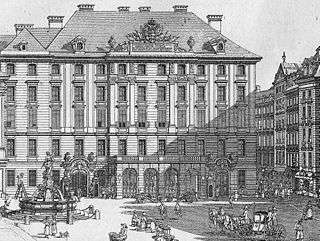Hofkriegsrat

The Hofkriegsrat (Imperial Council of War) established in 1556 was the central military administrative authority of the Habsburg Monarchy, the predecessor of the Austro-Hungarian Ministry of War. The agency was directly subordinated to the Habsburg emperors with its seat in Vienna.
History
Permanent council of wars had already be summoned by the Habsburg emperor Maximilian I about 1500. Founded in 1556 in the reign of Emperor Ferdinand I, the Steter Kriegsrat was a council of five generals and senior civil servants who controlled army appointments, the finances of warfare, and the deployment of forces. It also handled civil and military administration of the border region of Croatia.[1] With the establishment of an imperial standing army in the 17th century, the Hofkriegsrat was the bureaucracy charged with managing the permanent military force. It served as the central military administrative agency and a military chancery, provided a staff for the emperor, and directed and coordinated field armies.[2] Additionally, it conducted relations with the Ottoman Empire and administered the Military Frontier (Militärgrenze).[3]
All generals had to apply for authorisation for any strategic decisions, except for the generalissimo, a rule that ensured coordinated action but proved disadvantegeous facing an aggressive opponent like the Prussian king Frederick the Great. Emperor Joseph II further centralized the body and gave it supreme authority over all branches of the military administration. When the reforming Archduke Charles was appointed president of the Hofkriegsrat by Emperor Francis II in 1801, he divided the agency into three departments, dealing with military, judicial, and administrative matters.
Following the Napoleonic Wars, the Hofkriegsrat, as one of four components of the governing State Council (Staatsrat), continued to exert control over the military, subject of course to the will of the Emperor of Austria. However, its bureaucracy was cumbersome and decisions were often arrived at only after much argument and circulation of papers.[4] While the presidents were always officers, section heads were frequently civilians and there was often tension between them. The military men resented interference by what Radetzky would later call a civilian "despotism". An additional problem was presented in the fact that in a time when the general staff was growing in importance in other countries (notably Prussia), in Austria it remained only a subordinate section of the Hofkriegsrat.[4]
Amidst the growing nationalist troubles leading up to the 1848 Revolutions, the Hofkriegsrat investigated the reliability of units with suspect loyalties. In 1833 it ruled that all soldiers in the imperial army belonging to Mazzini's Italian nationalist Young Italy movement were guilty of high treason and were to be court-martialed. In the 1840s it investigated even the traditionally loyal South Slav Grenzer but determined that they would likely act as ordered, especially if in action against the Hungarians.[5]
With effect from 1 June 1848 the Hofkriegsrat was turned into the Austrian Ministry of War. According to the Austro-Hungarian Compromise of 1867, it became one of the three common ministries of the dual monarchy.
Presidents
- Ritter Ehrenreich von Königsberg 1556–1560
- Gebhard Freiherr von Welzer 1560–1566
- Georg Teufel, Freiherr von Guntersdorf 1566–1578
- Wilhelm Freiherr von Hofkirchen 1578–1584
- David Ungnad, Freiherr von Weißenwolf 1584–1599
- Melchior Freiherr von Redern 1599–1600
- Count Karl Ludwig Sulz 1600–1610
- Hans Freiherr von Mollard 1610–1619
- Johann Kaspar von Stadion 1619–1624
- Ramboldo, Count of Collalto 1624–1630
- Hans Christoph Freiherr von Löbel 1630–1632
- Count Heinrich Schlick 1632-1649
- Wenzel Fürst Lobkowitz, Duke of Sagan 1649–1665
- Annibale (Hannibal), Prince Gonzaga 1665–1668
- Raimondo Montecuccoli 1668–1681
- Hermann of Baden-Baden 1681–1691
- Ernst Rüdiger von Starhemberg 1692–1701
- Heinrich, Count Mansfeld, Prince of Fondi 1701–1703
- Prince Eugene of Savoy 1703–1736
- Dominik von Königsegg-Rothenfels 1736–1738
- Johann Philipp von Harrach 1738–1761
- Count Leopold Joseph von Daun 1762–1766
- Count Franz Moritz von Lacy 1766–1774
- Count Andreas Hadik von Futak 1774–1790
- Count Michael Joseph Wallis 1791–1796
- Friedrich Moritz, Count Nostitz-Rieneck 1796
- Count Ferdinand Tige 1796–1801
- Archduke Charles, Duke of Teschen 1801–1809
- Count Heinrich von Bellegarde 1809–1813
- Karl Philipp, Prince of Schwarzenberg 1814–1820
- Count Heinrich von Bellegarde 1820–1825
- Friedrich Franz Xaver Prince of Hohenzollern-Hechingen 1825–1830
- Count Ignaz Gyulai 1830–1831
- Count Johann Maria Philipp Frimont 1831
- Ignaz Graf Hardegg 1831–1848
- Count Karl Ludwig von Ficquelmont 1848
In fiction
In Tolstoy's War and Peace, a retired Russian officer, Prince Nikolai Andreevich Bolkonski, calls it the Hof-kriegs-wurst-schnapps-rat, mocking it by adding the well-known German words Wurst (sausage) and Schnapps (booze).
". . .and that's for all the world like the old Austrian Hofkreigsrath, as far as I can judge of military matters, that is. On paper, they'd beaten Napoleon and taken him prisoner and there in their study they worked it all out in the cleverest fashion. But look you, General Mack surrendered with all his army -- he-he-he. . ."—Porfiry Petrovitch (Crime and Punishment, Dostoevsky)
Bibliography
- ↑ Richard Holmes, ed. The Oxford companion to military history (2001) p 411.
- ↑ Rothenberg, Gunther E. (1976). The Army of Francis Joseph. West Lafayette: Purdue University Press. p. 4.
- ↑ Rothenberg 1976, p. 4.
- 1 2 Rothenberg 1976, p. 10.
- ↑ Rothenberg 1976, p. 19.
Further reading
- Eysturlid, Lee W. The Formative Influences, Theories, and Campaigns of the Archduke Carl of Austria (Greenwood, 2000).
- Rothenberg, Gunther E. (1976). The army of Francis Joseph. West Lafayette, Indiana: Purdue University Press. ISBN 0911198415. LCCN 75016051.
- Regele, Oskar. Der österreichische Hofskriegsrat, 1556-1848 (Verlag der Österreichischen Staatsdruckerei, 1949).
- Rothenberg, Gunther E. "The Croatian Military Border and the Rise of Yugoslav Nationalism." Slavonic and East European Review 43#100 (1964): 34-45.
- Schwarz, Henry Frederick and John Insley Coddington, The Imperial Privy Council in the Seventeenth Century (Oxford, 1943).
Coordinates: 48°12′38″N 16°22′06″E / 48.21056°N 16.36833°E